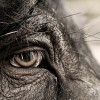Thomas Parsons grew up on a pig farm. So did his father, and his father’s father, and his father’s father’s father. The Parsons clan knows pigs and they know that pigs can be quirky. But does quirky equal personality? Parsons, a veterinary researcher at the New Bolton Center, the University of Pennsylvania School of Veterinary Medicine’s large animal campus in Kennett Square, wanted to know.
A farmer, especially one who raises an animal as notoriously smart and wily as the pig, is in a precarious position. Unless one limits production to a handful of pigs, treating every pig like Fido or Felo comes with a host of emotional and financial costs. A farm animal is treated as an individual but not as a pet. But as Parsons strives to create a better, loose housing system for gestating pigs, one where his sows are well-matched and intellectually stimulated, he has waded into the murky waters of animal personality.
Parsons recruited ethologist Tina Horback to his research team in order to help make sense of the pigs’ social world. Recently, for instance, they have been collecting data on personality differences in gestating sows. This leads to the question of what the best mix of different personality types would be to make the most functional social group. To answer this, they use what Parsons calls “the piggy Myers–Briggs experiment.”
Is it better to teach all children in the same classroom—catering to the middle—or to segregate by ability?
In one study, Horback started by taking a sow out of the pen and offering it a food bowl. Sometimes she placed the bowl on the sow’s right and sometimes on its left. Whenever it was on the right, though, the bowl was empty and if the sow went to try to eat, a red bag was rustled in its face (unpleasant, but not harmful). Soon, the sows learned to only go to the bowl when it was on the left. But then Horback placed the bowl in the middle of the room to see how the sows would respond to this new, ambiguous situation. She found that two-thirds went for the bowl while the remaining third, wary of getting a bag in the face, hung back. The findings will be presented at the annual meeting of the International Society for Applied Ethology this summer in Vitoria-Gasteiz, Spain.
We know from human studies that our emotional states shape how we make decisions. Crucially, when we’re in a bad mood, we feel more pessimistic about the future and respond negatively to ambiguous stimuli, whereas when we feel good we extend our sunny, optimistic view into the future. Although Parsons is worried about anthropomorphizing too much, he suspects that the sows that went for the food in the middle at least see the world differently than those that didn’t. When he observed them in the pen, he found that they also entered the feeding station before the rest of the group, a sign of social dominance. In other words, potentially optimistic sows were more likely to sit at the top of the social ladder.
The finding has also lead Parsons to wonder if the seemingly obvious solution to limiting strife in the pens—removing the aggressive, dominant sows who are ready to fight to the top of the pecking order—might backfire. If those dominant pigs are considered the optimists of the group, you could be left with “a bunch of depressed animals,” he quips.
Jokes aside, if these early results are more widely confirmed then it puts him in a bit of a quandary. To use an analogy from education: Is it better to teach all children in the same classroom—catering to the middle—or to segregate by ability? “How do we design a welfare-friendly system that meets the needs of all the animals in the pen?” Parsons asks.

RELATED STORY
This post originally appeared on Mosaic as “If a Pig Had a Better Personality…” and is republished here under a Creative Commons license.





